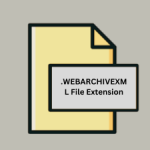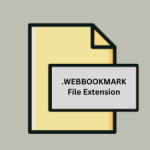.OAM File Extension

Adobe Edge Animate Widget File
| Developer | Adobe Systems |
| Popularity | |
| Category | Web Files |
| Format | .OAM |
| Cross Platform | Update Soon |
What is an OAM file?
The .OAM file extension represents an Adobe Edge Animate Widget. Adobe Edge Animate was a software application used for creating interactive animations and multimedia content, particularly for HTML5 websites. The .OAM files are used to package these animations and widgets for easy integration into web pages or other projects.
More Information.
- History: Adobe Edge Animate was first released in 2011 as part of Adobe’s suite of web development tools. The
.OAMfile format was introduced to support the packaging of animations created within Edge Animate. - Initial Purpose: The purpose of the
.OAMfile was to encapsulate animations and interactive elements created in Edge Animate into a single, portable file that could be easily inserted into HTML5 web pages or other environments.
Origin Of This File.
Adobe Edge Animate was developed by Adobe Systems, primarily aimed at providing web designers and developers with tools to create HTML5-based animations. The .OAM file extension was introduced as part of Adobe Edge Animate to streamline the creation and integration of complex animations into web environments.
File Structure Technical Specification.
- File Structure:
.OAMfiles are essentially ZIP archives that contain various resources needed for the animation, including HTML, CSS, JavaScript, and media files. - Technical Specification: Inside the
.OAMfile, you’ll find:- HTML: The structure of the animation or widget.
- CSS: Styling rules applied to the animation.
- JavaScript: Scripts that manage the behavior and interactivity of the animation.
- Assets: Images, audio, and other media used in the animation.
How to Convert the File?
Windows
- Extract the Contents:
- Rename the
.OAMfile to.ZIP(e.g.,example.oamtoexample.zip). - Use a file extraction tool (such as WinRAR, 7-Zip, or the built-in Windows Explorer) to extract the contents.
- Rename the
- Edit the Files:
- Open and modify the extracted HTML, CSS, and JavaScript files using a text editor (such as Notepad++ or Visual Studio Code) or a web development IDE.
- Repackage the Files:
- After editing, re-compress the modified files into a ZIP archive.
- Rename the
.ZIPfile back to.OAM(e.g.,example.ziptoexample.oam).
- Convert to Other Formats (if needed):
- If you need the content in a different format, convert the HTML, CSS, or JavaScript files to your desired format using appropriate tools or scripts.
Linux
- Extract the Contents:
- Rename the
.OAMfile to.ZIP(e.g.,example.oamtoexample.zip). - Use the
unzipcommand or a file manager (such as Nautilus or Dolphin) to extract the contents.
- Rename the
- Edit the Files:
- Use a text editor (like Vim, Nano, or Visual Studio Code) or a web development IDE to modify the extracted HTML, CSS, and JavaScript files.
- Repackage the Files:
- After editing, re-compress the files into a ZIP archive.
- Rename the
.ZIPfile back to.OAM.
- Convert to Other Formats (if needed):
- Use conversion tools or scripts to change the HTML, CSS, or JavaScript files to the desired format.
macOS
- Extract the Contents:
- Rename the
.OAMfile to.ZIP(e.g.,example.oamtoexample.zip). - Use macOS’s built-in Archive Utility or a third-party tool (like The Unarchiver) to extract the contents.
- Rename the
- Edit the Files:
- Open and modify the extracted files with a text editor (such as TextEdit or Sublime Text) or a web development IDE.
- Repackage the Files:
- After editing, compress the files back into a ZIP archive:
- Select the files and right-click to choose “Compress”.
- Rename the
.ZIPfile back to.OAM:- Use Finder or Terminal.
- After editing, compress the files back into a ZIP archive:
- Convert to Other Formats (if needed):
- Convert the HTML, CSS, or JavaScript files to other formats using appropriate tools or methods.
Android
- Extract the Contents:
- Use a file manager app that supports ZIP archives (like ZArchiver) to rename the
.OAMfile to.ZIPand extract it.
- Use a file manager app that supports ZIP archives (like ZArchiver) to rename the
- Edit the Files:
- Use a text editor app (such as QuickEdit or Jota Text Editor) to modify the HTML, CSS, and JavaScript files.
- Repackage the Files:
- Re-compress the modified files into a ZIP archive using the file manager app.
- Rename the
.ZIPfile back to.OAMif possible, though some file manager apps may not support renaming extensions.
- Convert to Other Formats (if needed):
- For more complex conversions, use online tools or transfer the files to a desktop environment.
iOS
- Extract the Contents:
- Use a file manager app (like iZip or Documents by Readdle) to rename the
.OAMfile to.ZIPand extract it.
- Use a file manager app (like iZip or Documents by Readdle) to rename the
- Edit the Files:
- Edit the extracted HTML, CSS, and JavaScript files using a text editor app (such as Textastic or Koder).
- Repackage the Files:
- Re-compress the edited files into a ZIP archive using the file manager app.
- Renaming the ZIP file back to
.OAMmay be limited, but you can transfer the files to a desktop environment for this step.
- Convert to Other Formats (if needed):
- Use online tools or transfer the files to a desktop environment for more complex conversions.
Others
- Extract the Contents:
- Rename the
.OAMfile to.ZIPand use a file extraction tool to access the contents.
- Rename the
- Edit the Files:
- Modify the HTML, CSS, and JavaScript files as needed using an appropriate text editor or IDE.
- Repackage the Files:
- Recompress the files into a ZIP archive and rename it back to
.OAMif required.
- Recompress the files into a ZIP archive and rename it back to
- Convert to Other Formats (if needed):
- Use conversion tools or scripts suitable for the target format.
Advantages And Disadvantages.
- Advantages:
- Portability: Easily transferable and integrable into web projects.
- Self-Contained: Bundles all necessary resources for the animation.
- Simplifies Integration: Makes it straightforward to embed animations into web pages.
- Disadvantages:
- Limited Support: Edge Animate has been discontinued, so support for
.OAMfiles may be limited. - Compatibility Issues: May require specific web environments or tools for proper rendering and integration.
- Limited Support: Edge Animate has been discontinued, so support for
How to Open OAM?
Open In Windows
- Adobe Edge Animate: Although discontinued, older versions can still be used to open and edit
.OAMfiles. - Extract and Edit: Rename
.OAMto.ZIP, extract the contents, and edit the individual files (HTML, CSS, JavaScript) using text editors or web development tools.
Open In Linux
Extract and Edit: Rename the .OAM file to .ZIP, extract it using archive tools (like unzip), and edit the contents with text editors or IDEs.
Open In MAC
- Adobe Edge Animate: Available on older macOS versions; otherwise, use alternative tools.
- Extract and Edit: Rename
.OAMto.ZIP, extract with built-in Archive Utility, and edit the files.
Open In Android
Limited Support: Directly opening .OAM files is not supported. However, you can extract the contents if you use a file manager app that supports ZIP archives and then view/edit the files with compatible apps.
Open In IOS
Limited Support: Similar to Android, direct opening is not supported. Extracting .OAM files may require specific apps that handle ZIP files and support editing of web assets.
Open in Others
Web Browsers: While you can’t directly open .OAM files in web browsers, you can manually extract and view the contents. For viewing the animation, you’d need to integrate it into an HTML5 page and view it through a web browser.













